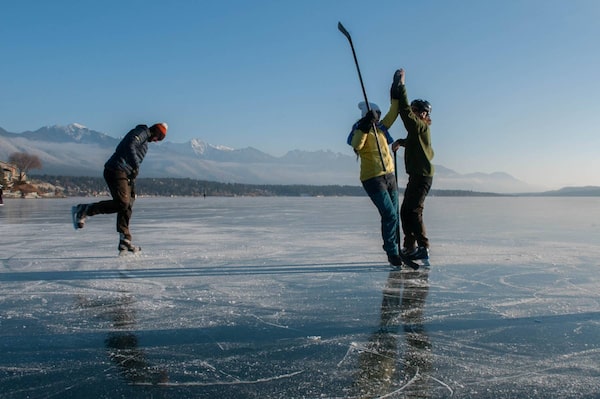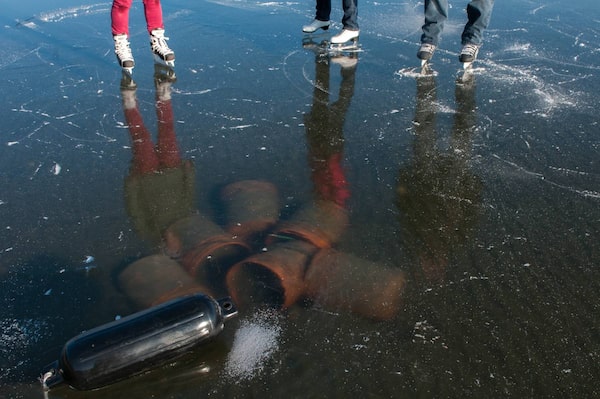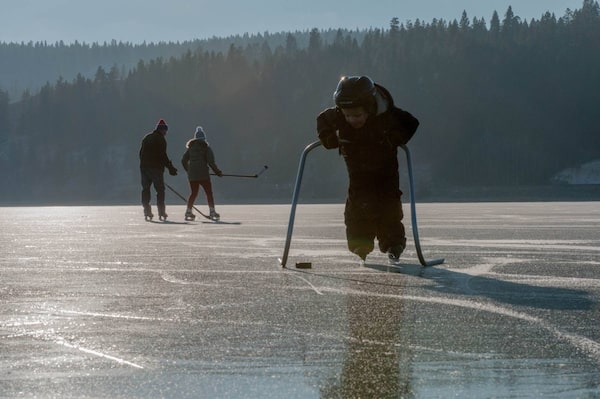
People play a game of shinny on Lake Windermere in B.C.Ruth Fast/The Globe and Mail

Brad Allen in background - On right Marcie and Stef playing hockey and scoring in a game of shinny on Lake Windermere - December 13, 2017 - Photo Credit Ruth Fast/.GlobeandMailRuth Fast/ The Globe and Mail/The Globe and Mail
Lisa Roddick is wearing a pink toque with a blue pom-pom. She’s in goal. Her husband, James, wearing a black Leaside Lancers hockey jersey from his high school days, is coming her way with the puck.
The pair did not come to British Columbia's Lake Windermere just to play shinny with their pals. They came to see a scientific rarity: black ice.
Right now, skaters near Lake Windermere's shores can see the bottom as if they were looking through a window. Fish swimming. Clamshells resting in sandy ripples. Makeshift boat anchors connected to rusty chains waiting for next summer.
Farther from shore, where the water is deeper and light cannot penetrate, the ice looks like it is dyed black. The Roddicks and three friends adhere to shinny etiquette, playing far from shore to stay clear of kids and casual skaters in Taynton Bay. The lake's ice sheet is nearly flawless, smooth on the surface with uniform clarity and colouring below. Frozen water has folks here in Invermere, B.C., on the northern tip of the lake, excited.
Mr. Roddick plays the puck off his skate, back to his stick. He banks a shot off the puffy purple coat serving as a goal post but cannot get the rubber across the imaginary goal line.
"Eat that, husband," Ms. Roddick says. The boys-against-girls shinny game in the Columbia Valley plays on. The Rocky Mountains line the east side of the lake, the Purcells frame the west.
Watch: Skaters glide over rare black ice on Lake Windermere in B.C.’s Columbia Valley.
WATCH Skaters glide over rare black ice on Lake Windermere in B.C.’s Columbia Valley
The Roddick crew came from Golden, about 120 kilometres away, after watching a Facebook friend's video of himself skating on the see-through ice.
"This is the most Canadian day ever," Mr. Roddick says as the group drinks Pilsner and grapefruit Palm Bays after the game. "You have a rink that is flooded perfectly and goes forever. No one has to shovel."
Dozens of skaters glide on this winter anomaly. Some push baby strollers. Gene Matsalla is 77, has lived here for more than 30 years and never seen the ice this clear. "Everything is kind of freaky," he says. Mr. Matsalla is wearing a trapper's hat and gets a kick out of how many kids are here rather than in school. "What the heck," he says. "Mother nature is co-operating."
Perfect conditions are needed for black ice. No wind. No snow. No moving water. A slow freeze. Lake Windermere is not a prime candidate because it is so large – about 17 kilometres long and a couple of kilometres across. It is technically a wide stretch of the Columbia River.
"It is such a unique situation," says Brian Moorman, a geography professor who specializes in permafrost and glaciers at the University of Calgary. "To get a really nice clear black ice like that, it is going to take days and days."
All ice crystals have six sides, grow from the top down, and bond to their neighbours to form a sheet. Black ice forms when the crystals grow perpendicular to the surface and parallel to each other, undisturbed by wind and other factors. These crystals will be the same size and shape, like a new set of dinner candles perfectly packaged and standing on end. When ice crystals grow vertically and bond perfectly, light passes through without distorting.
"That's why it looks so clear," Prof. Moorman says. "It is magical."

Boat anchors lie beneath the frozen surface of the lake.
He estimates Lake Windermere's ice crystals would be between a few millimetres and one centimetre wide. The ice is about 13 centimetres thick right now, meaning the crystal columns will be the same length.
Most bodies of water have "white ice" when they freeze. These crystals are smaller and grow in different directions. Perhaps moving water interrupted a crystal's growth or influenced its direction. Maybe snow mucked up the freezing process. The water probably froze quickly. The crystals still bond together, but because they grew in all directions and are different sizes, uniform columns are impossible. Light cannot get through mish-mashed ice crystals. The result: opaque ice.
Gas also messes with perfection, according to Matti Lepparanta, a geophysics professor at the University of Helsinki in Finland. "Gas bubbles accumulate in the ice cover and the more there are bubbles, the more opaque the ice," the snow and ice expert said. Gas can come from lake water and lake bottoms. Bubbling springs also cause interference.

Rory and Theresa fool around with the puck in the distance. In the foreground, Johnny Shane learns to skate.
Calgary is about 275 kilometres from Invermere, which sits between Radium Hot Springs and Fairmont Hot Springs. Lake Windermere is the area's defining feature.
Geography does not limit black ice. It has formed on Russia's Lake Baikal, which holds one-fifth of the world's fresh water. It has taken over parts of the Ottawa River. Calgarians rush to mountain lakes when the phenomenon strikes. This year, black ice formed on Two Jack Lake, Parks Canada says. That lake is about 130 kilometres west of Calgary.
Black ice's cosmetic characteristics are fleeting. The white streaks skaters leave are instant imperfections. Snow will, inevitably, cover the ice. Melting and refreezing changes its complexion. That's why folks like Theresa Wood keep ducking out of work to go skating.
"It feels surreal," she says after returning to work at Taynton Bay Spirits, a distillery near Invermere's Kinsmen Beach. "It feels like you are skating on nothing."
She spotted a black pair of sunglasses under the ice the other day. Her son Bryan, who is 5, tracks discoveries, too. "Shells and golf balls and some trash," he says.
Isaac McLeod is skating for the first time, unaware of his lucky timing. He's four, his skates are blue and white, and he falls frequently. "That's one thing I know," he says.
Meanwhile, the Roddicks and their friends are tabulating the day’s stats: An iPhone app tells them they skated about 17 clicks. They ripped around for three and a half hours. The three girls beat the two boys 4 to 1, maybe. “Okay. We’ll say 5 to 2,” Marcie Trenholm says.
 Carrie Tait
Carrie Tait